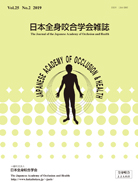The purpose of this study was to clarify the usefulness of a newly developed prototype occlusal force measuring device. Using a calibration pressure device, seven types of loads from 100 N to 700 N were applied to the prototype occlusal force measuring device 20 times each 100 N, and the resistance values were recorded. With respect to 20 times of recorded data (reciprocal of resistance value), changes over time were examined using a repeated measures analysis of variance. After calculating the calibration line (y=ax+b) from the first 10 recorded data, the pressure value was calculated by substituting the remaining 10 recorded data with y in this linear equation (x=(y-b)/a). The coefficient of variation was calculated from the average value and standard deviation of the 10 measurements. Furthermore, the relative error ((measured value-theoretical value)/ theoretical value) was calculated. Next, 20 healthy subjects were asked to perform maximum clenching for 3 seconds using a bite force analyzing system (Dental Prescale II, GC)and a prototype occlusal force measuring device, and the maximum occlusal force was calculated. Then investigated whether there was any correlation between the two. The reciprocal of the resistance values for each load from 100 N to 700 N were approximately similar, and did not increase or decrease over time(F=1.481, p=0.106). The calibration straight line obtained from the first 10 recorded data was y=0.5211x+59.329. The pressure value obtained from the remaining 10 recorded data approximated to the load value, and the coefficient of variation was less than 3 % and the relative error was less than 2 %. There was a statistically significant positive correlation between the maximum occlusal force measured using a prototype device and the maximum occlusal force measured using a Dental Prescale II (r=0.577, p=0.004). From these results, it was suggested that the newly developed prototype occlusal force measuring device is useful and clinically applicable.
View full abstract
